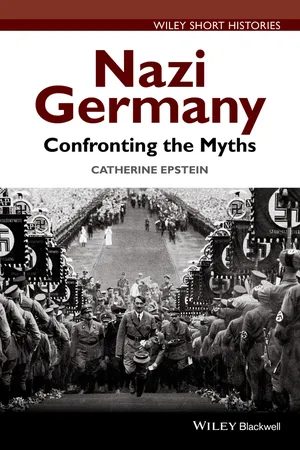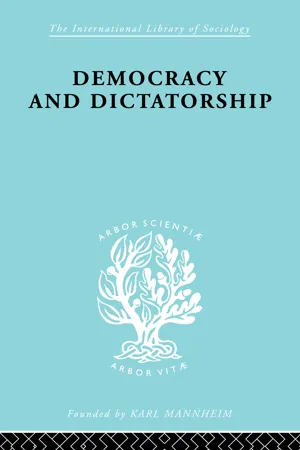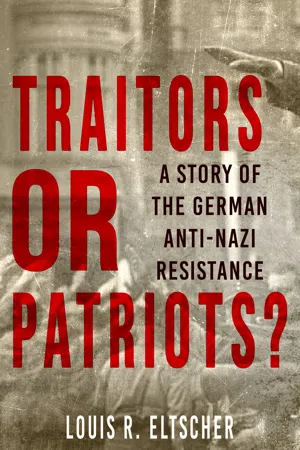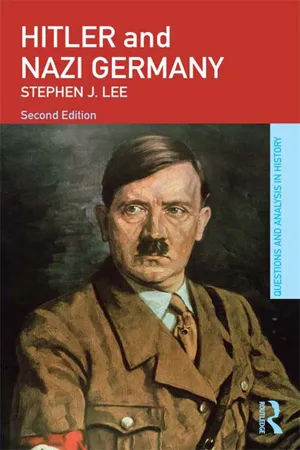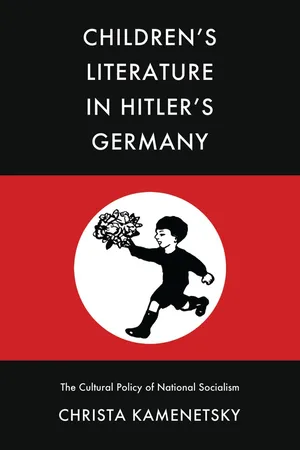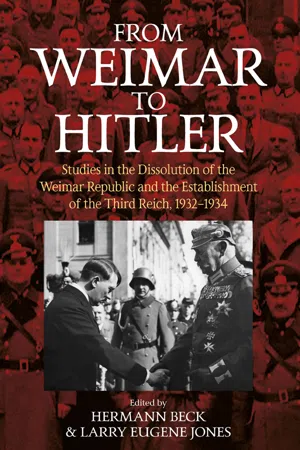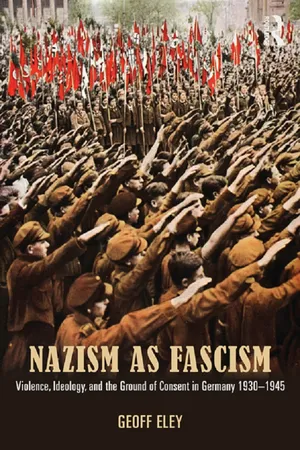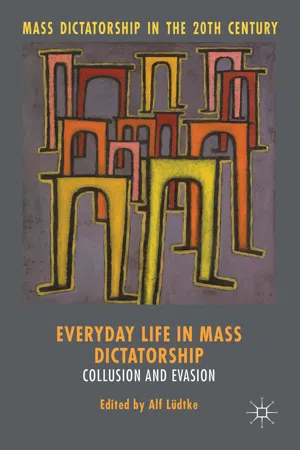History
Nazi Control
Nazi control refers to the totalitarian rule established by the National Socialist German Workers' Party (Nazi Party) in Germany from 1933 to 1945. Under the leadership of Adolf Hitler, the Nazis implemented a regime characterized by censorship, propaganda, persecution of minorities, and the suppression of political opposition. This control extended to all aspects of society, including the economy, education, and culture.
Written by Perlego with AI-assistance
Related key terms
Related key terms
1 of 4
Related key terms
1 of 3
8 Key excerpts on "Nazi Control"
- eBook - ePub
Nazi Germany
Confronting the Myths
- Catherine A. Epstein(Author)
- 2014(Publication Date)
- Wiley-Blackwell(Publisher)
3 The Nazi Party-State“If we do one day achieve power,” Adolf Hitler told a crowd on October 17, 1932, “we will hold on to it, so help us God. We will not allow them to take it away from us again.” Hitler held true to his words. After he came to power, he established a dictatorial regime. He eliminated the last vestiges of the parliamentary order. Brooking no challenge to his rule, he destroyed the political opposition. It would take World War II, and the combined might of the Allies, to dislodge Hitler from power.There is a myth that the Third Reich terrorized all Germans into fearful submission. While terror and coercion did accompany the regime’s consolidation, the reality of Nazi dictatorship was more complex. There is also a myth that the Nazi dictatorship was an efficient, streamlined operation. Once installed, however, the Nazi regime was chaotic. Hitler rarely made decisions, leaving officials to discern his wishes. Party and state offices duplicated each other. The regime fragmented into the personal fiefdoms of top Nazis.This chapter outlines how Hitler achieved total control of Germany. It details the imposition of one-party rule. It explores the process of Gleichschaltung (coordination) – that is, how the Nazis came to control German society. It then turns to how Hitler destroyed the paramilitary Sturmabteilung (SA) and its leader, Ernst Röhm. Next, it describes the coercive apparatus of the Third Reich, especially the all-important fusion of the police and the Schutzstaffel (SS), the Nazi Party’s “Protection Squad.” Finally, it raises intriguing questions about the nature of Nazi dictatorship. How did the dualism of party-state rule play out? What role did Hitler play in the Third Reich? Was he a “strong” or “weak” dictator?The Death of Democracy
Once appointed chancellor on January 30, 1933, Hitler headed a cabinet in which he was one of just three Nazis. Besides Hitler, Wilhelm Frick was interior minister and Hermann Göring minister without portfolio. Otherwise, Franz von Papen was vice-chancellor. Alfred Hugenberg, leader of the conservative German National People’s Party (DNVP), was economics minister. Franz Seldte, head of the Stahlhelm, the paramilitary veterans’ organization, was minister of labor. President Paul von Hindenburg had personally chosen the minister of defense, General Werner von Blomberg. Other ministers were holdovers from the Brüning, Papen, and Schleicher governments. With so many non-Nazi ministers, it seemed that Hitler would have little leeway to determine developments. - eBook - ePub
Democracy and Dictatorship
Their Psychology and Patterns
- Zevedei Barbu(Author)
- 2013(Publication Date)
- Routledge(Publisher)
Chapter One Dictatorship of the Right
DOI: 10.4324/9781315888712-12‘ . . . nothing appears more surprising to those who consider human affairs with a philosophical eye than the easiness with which the many are governed by the few.’ David HumeThe German political régime of the period between 1933-45 is generally known under the name of Nazism or Hitlerism. Though lasting a relatively short time it embodied in its doctrine and practice the most characteristic totalitarian trends of our century. Like Italian Fascism and many other Fascist movements, Nazism was a dictatorship of the right, a political organization based on exclusivist and aggressive nationalism under the personal dictatorship of a leader.From the political point of view Nazism was characterized by the concentration of absolute power in the hands of a leader who exercised it by means of his own party organized in a military manner. It was a typical one-party system in which democratic electoral methods were replaced by occasional plebiscites on issues selected by the leader.From the economic point of view Nazism was a case of a controlled economy. In principle the system of private ownership remained untouched. Free enterprise, however, was considerably limited by the interference of the State in the processes of production and distribution.The Nazi régime required the individual's total integration with the aims of his group as represented by the leader and his party. Nazis were against that kind of life which allows the individual a ‘quiet’ fulfilment of his social duties. They asked for enthusiasm and sacrifice for the common cause. Nazism was firstly a stato d'animo (Mussolini) and only in the second place a political formula.At the cultural level Nazism was a case of directed culture, with an official ideology, coined by the leaders of the Party and enforced upon the whole cultural activity of the community. The cultural outlook had a strong mystic character, without being religious; it was idealistic, and yet not oriented towards spiritual values; it called itself revolutionary, and in spite of this it was not progressive, but on the contrary, traditionalist. The ideal of man was embodied in the strong man or in the possessor of political power. - eBook - ePub
Traitors or Patriots?
A Story of the German Anti-Nazi Resistance
- Louis R. Eltscher(Author)
- 2020(Publication Date)
- McNidder and Grace(Publisher)
3Here was a system that sought to exercise – and in many cases succeeded in exercising – control over both mind and body. Unlike a simple police state that represses dissident behavior but generally ignores one’s thoughts so long as those thoughts do not produce actions detrimental to its power and control, a totalitarian state such as the Third Reich wished to control what people thought as well as what they did. Moreover, the Reich achieved this goal while maintaining a “veneer of legality.”4 The Nazi use of language was an important part of this process.The People React
Unsurprisingly, a wide range of reactions among the German people greeted the momentous events of early 1933, from wild enthusiasm to sullen or fatalistic acceptance to determined opposition. For many – perhaps most – there was fear and apprehension. Events completely beyond their control threatened to overwhelm them completely. These years marked the depth of the Depression, with the fear of unemployment and the prospect of financial catastrophe an ever-present reality. In such insecure circumstances, “not to have gone along with the Nazis would have meant risking one’s livelihood and prospects, [and] to have resisted could mean risking one’s life.”5 People from all walks of life accommodated themselves to the new as best they could. In such circumstances, often the safest option is to say nothing, and many concealed their true feelings about Nazism behind a wall of silence. Rudolf Steiner, a Jewish Berliner, examined the overall reaction to the abrupt changes that took place after January 30, commenting as follows:People have transformed themselves … they put on masks. No one knows what the individual thinks [or] … what he feels, whether he hopes for the fall of this regime … because even the loudest spokesmen for the Nazis do not prove with their cheers that they believe in the ideology … What do the masses think? You can hardly guess … The masses, as well as individuals who are not Nazis, are silent and wait.6 - eBook - ePub
- Stephen J. Lee(Author)
- 2013(Publication Date)
- Routledge(Publisher)
Volksgemeinschaft. Others were excluded: social ‘deviants’, hereditarily ‘diseased’, ‘undesirable’ groups and racial ‘inferiors’ – especially Romanies and Jews. For some of these the state exercised punitive powers, for others the protection normally conferred by the state on behalf of its citizens was removed altogether. The implications were huge, with the passing of discriminatory legislation such as the Nuremberg Laws (1935), the growth of a network of concentration camps, the compulsory sterilisation of targeted individuals and groups, and, in extreme cases, the application of ‘euthanasia’. Above all, a policy of extermination was adopted from 1941 onwards. In the Nazi dictatorship the role of the state was therefore not only that of ‘selector’, but also of ‘eliminator’. This is the most extreme function – or malfunction – that any state is capable of fulfilling.Questions
- In what ways did the Nazi dictatorship differ from the ‘Presidential dictatorship’ of the last two years of the Weimar Republic?
- To what extent did the Nazis change Germany institutionally after 1933?
Analysis 2: How Effective was the Nazi Political System?
The nazification of the whole system of government in Germany might suggest that the organisation was tight and carefully structured. The precision with which the Nazi legal revolution occurred also infers that Hitler had full control over the whole process. The Third Reich, in other words, might be seen as a model of efficiency precisely because the effort taken to establish it had been so minimal.Such an approach would, however, be open to fundamental question and a number of historians have presented a very different picture. It is generally argued that, far from being orderly, the Nazi dictatorship was actually prone to internal conflict which resulted in a surprising degree of chaos. The basic problem was that the Third Reich was a hotchpotch of overlapping institutions and structures. This was the result of the minimalist approach to constitutional change. Instead of knocking down the old structure, the Nazis had simply constructed another on top of it. The effect was the duplication of functions and the conflict between officials in central and local government. This was apparent even to contemporaries; Otto Dietrich, Hitler’s press chief, later wrote in his Memoirs: ‘In the twelve years of his rule in Germany Hitler produced the biggest confusion in government that has ever existed in a civilized state.’ (See Source 1.3 - eBook - ePub
Children's Literature in Hitler's Germany
The Cultural Policy of National Socialism
- Christa Kamenetsky(Author)
- 2019(Publication Date)
- Ohio University Press(Publisher)
PART IV Methods and Limitations of ControlPassage contains an image 14 The System of Censorship
The control over children’s literature in Nazi Germany was closely linked with the control over literature in general. In both cases, the authority was divided between Goebbels and Rosenberg representing the State and the Party respectively. The Reichsschrifttumskammer (Reich Literature Chamber) with its various subdivisions had the executive power to prohibit books and to punish authors, publishers or booksellers who did not abide by its rules. The various documents published by the Reich Literature Chamber became laws to the nation. According to a decree of November 1, 1933, everyone in Germany had to submit to its screening process all materials that were connected with “the creation, reproduction, recital, spiritual or technical interpretation, distribution, maintenance, trade or sale of cultural goods.”1 The following document, dating from 1935, may convey an idea of the all-embracing nature of censorship as Goebbels had designed it:The Reich Literature Chamber issues a list of harmful and undesirable literature containing all works of literature opposed to the cultural and political goals of the National Socialist State. It is prohibited by law to publish, sell, lend, borrow, issue, advertise, sell, or store these books. This prohibition applies to works of authors of Jewish or semi-Jewish origin, even if their works are not included in the above mentioned list, and it is also applicable to the literature in the newly acquired territories in the east.2Goebbels issued such a list periodically, which was consulted by Rosenberg’s various censorship offices. On occasion, it referred to books for young people under the age of eighteen, although it made no special provisions for children’s literature. - eBook - ePub
From Weimar to Hitler
Studies in the Dissolution of the Weimar Republic and the Establishment of the Third Reich, 1932-1934
- Hermann Beck, Larry Eugene Jones, Hermann Beck, Larry Eugene Jones(Authors)
- 2018(Publication Date)
- Berghahn Books(Publisher)
12 Outmaneuvering their conservative allies at every turn, the Nazis were able to establish what amounted to a one-party dictatorship with little, if anything, in the way of organized resistance.The third phase in the Nazi seizure of power began with Hitler’s announcement in mid-July 1933 that the Nazi revolution had accomplished its objectives with the destruction of the Weimar state and that it was now time for a period of consolidation and renewal. This held obvious implications for Hitler’s storm troopers (Sturm-Abteilungen der NSDAP or SA), the paramilitary wing that had been the principal agent of the Nazi revolution and now found itself relegated to the sidelines at least for the foreseeable future. The second half of 1933 was characterized by a relative calm that stood in sharp contrast to the preceding six months; a new normal had settled upon the country. But by the end of the year, there were signs of increasing unrest, particularly within the SA, whose leader Ernst Röhm began to make vague allusions to a “second revolution” in which the social promise of the Nazi revolution would be finally fulfilled. Rumors of a “second revolution” in which the destruction of the Weimar state was to be followed by a redistribution of wealth and property had an unnerving effect on Hitler’s conservative allies and threatened to undermine their loyalty to the regime.13 Nowhere was this more apparent than at the upper echelons of Germany’s military establishment, where Röhm’s plans for a “people’s army” created through the amalgamation of the Reichswehr and SA had aroused particular concern.14 As tension began to build through the late spring and early summer of 1934, Hitler and his closest supporters were finally forced into action by a speech that Franz von Papen, the vice chancellor in the Hitler cabinet and the putative leader of the conservatives who had allied themselves with Hitler, delivered at the University of Marburg on 17 June. Here Papen gave voice to the growing fears of Germany’s propertied classes about the rumors of a “second revolution,” drew public attention to the discrepancy between the promise and practice of the Nazi revolution, and announced that it was time to transform the Nazi revolution into a “conservative revolution” based upon a reaffirmation of the spiritual values that lay at the heart of Germany’s national greatness. Papen’s speech forced Hitler’s hand, and on 30 June 1934 Hitler and a small circle of associates launched a two-pronged strike against the SA and those conservatives who had conspired to remove Hitler from office in what came to be known as Hitler’s “Night of the Long Knives.”15 - eBook - ePub
Nazism as Fascism
Violence, Ideology, and the Ground of Consent in Germany 1930-1945
- Geoff Eley(Author)
- 2013(Publication Date)
- Routledge(Publisher)
58 The penultimate chapter, “Toward Utopia through Terror,” resumes treatment of the “SS Empire,” continuing into the forced movement and enslavement of subject populations, and ending with the “Final Solution.” The final chapter deals with the army.For Ayçoberry, the Third Reich began and ended in violence. On the foundations of repression and terror, which destroyed the labor movement and other key resources for democracy, the dictatorship became institutionalized with a ruthlessness that rapidly coopted the judiciary and dismantled the rule of law. Nazism’s totalizing ambitions relentlessly reduced “society” to the regime’s needs. Wartime then brought the expansion of the SS empire, with its horrendously generalized machinery of mass coercion, racialized exploitation, and government by terror, itself the brutal, systematized apotheosis of the wider violence of the regime, brought ever closer to home by the tightening military fronts, aerial bombardment, and states of emergency. Into the emptied societal arena, purged and bludgeoned into conformity during 1933 to 1934, came the new official agencies and mass apparatuses of the Party-state, purveyors of the organized myth of the Volksgemeinschaft - eBook - ePub
Everyday Life in Mass Dictatorship
Collusion and Evasion
- Alf Lüdtke, Alf Lüdtke, Alf Lüdtke(Authors)
- 2016(Publication Date)
- Palgrave Macmillan(Publisher)
Part IIDictatorial and Colonial Regimes 1930–1960: Practices of Domination and Modes of AppropriationPassage contains an image 3 The Third Reich: Police State or Self-Policing Society?
Peter Lambert1A largely Anglophone history of the Third Reich ‘from below’ was initially anchored in the neo-Marxism of the New Left. It was informed by essentially optimistic assumptions about the self-activity and liberatory capacity of the working class and of ‘ordinary’ Germans more generally. From the late 1960s to the early 1980s, much of the most exciting work on the Third Reich was conducted in this spirit. The later 1980s witnessed the virtual collapse of Marxism and of the New Left. However, history ‘from below’ not only survived the disintegration of its original intellectual home, but in fact expanded, becoming increasingly ambitious in its attempts at explaining Nazism and Nazi rule. The focus of its practitioners shifted from the study of resistance to explorations of the rise of Nazism – locating it in the context of the emergence of a demotic, populist Right whose force was felt before the Nazis’ own emergence as a mass Party – and of popular collaboration with the Nazi regime.2Once optimism about ‘ordinary’ Germans and their behaviour under conditions of dictatorship had given way to a pervasive pessimism, historians writing ‘from below’ began a fundamental re-appraisal of the workings of totalitarianism. They suggested, for instance, that the criminalisation of warfare on the Eastern Front is inexplicable without reference to the barbarising contributions of ‘ordinary’ Wehrmacht soldiers,3 and drew our attention to the role of ordinary policemen in the mass murder of Jews.4
Index pages curate the most relevant extracts from our library of academic textbooks. They’ve been created using an in-house natural language model (NLM), each adding context and meaning to key research topics.
Explore more topic indexes
Explore more topic indexes
1 of 6
Explore more topic indexes
1 of 4
